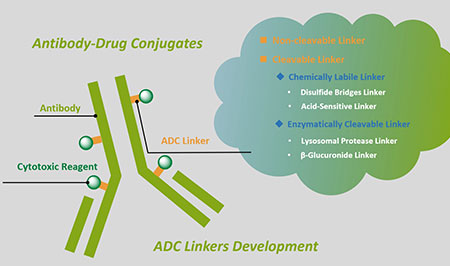1.Enhanced activity of monomethylauristatin F through monoclonal antibody delivery: effects of linker technology on efficacy and toxicity
Doronina SO, Mendelsohn BA, Bovee TD, Cerveny CG, Alley SC, Meyer DL, Oflazoglu E, Toki BE, Sanderson RJ, Zabinski RF, Wahl AF, Senter PD
We have previously shown that antibody-drug conjugates (ADCs) consisting of cAC10 (anti-CD30) linked to the antimitotic agent monomethylauristatin E (MMAE) lead to potent in vitro and in vivo activities against antigen positive tumor models. MMAF is a new antimitotic auristatin derivative with a charged C-terminal phenylalanine residue that attenuates its cytotoxic activity compared to its uncharged counterpart, MMAE, most likely due to impaired intracellular access. In vitro cytotoxicity studies indicated that mAb-maleimidocaproyl-valine-citrulline-p-aminobenzyloxycarbonyl-MMAF (mAb-L1-MMAF) conjugates were >2200-fold more potent than free MMAF on a large panel of CD30 positive hematologic cell lines. As with cAC10-L1-MMAE, the corresponding MMAF ADC induced cures and regressions of established xenograft tumors at well tolerated doses. To further optimize the ADC, several new linkers were generated in which various components within the L1 linker were either altered or deleted. One of the most promising linkers contained a noncleavable maleimidocaproyl (L4) spacer between the drug and the mAb. cAC10-L4-MMAF was approximately as potent in vitro as cAC10-L1-MMAF against a large panel of cell lines and was equally potent in vivo. Importantly, cAC10-L4-MMAF was tolerated at >3 times the MTD of cAC10-L1-MMAF. LCMS studies indicated that drug released from cAC10-L4-MMAF was the cysteine-L4-MMAF adduct, which likely arises from mAb degradation within the lysosomes of target cells. This new linker technology appears to be ideally suited for drugs that are both relatively cell-impermeable and tolerant of substitution with amino acids. Thus, alterations of the linker have pronounced impacts on toxicity and lead to new ADCs with greatly improved therapeutic indices.
2.Enzymatic prenylation and oxime ligation for the synthesis of stable and homogeneous protein-drug conjugates for targeted therapy
Lee JJ, Choi HJ, Yun M, Kang Y, Jung JE, Ryu Y, Kim TY, Cha YJ, Cho HS, Min JJ, Chung CW, Kim HS
Targeted therapy based on protein-drug conjugates has attracted significant attention owing to its high efficacy and low side effects. However, efficient and stable drug conjugation to a protein binder remains a challenge. Herein, a chemoenzymatic method to generate highly stable and homogenous drug conjugates with high efficiency is presented. The approach comprises the insertion of the CaaX sequence at the C-terminal end of the protein binder, prenylation using farnesyltransferase, and drug conjugation through an oxime ligation reaction. MMAF and an EGFR-specific repebody are used as the antitumor agent and protein binder, respectively. The method enables the precisely controlled synthesis of repebody-drug conjugates with high yield and homogeneity. The utility of this approach is illustrated by the notable stability of the repebody-drug conjugates in human plasma, negligible off-target effects, and a remarkable antitumor activity in vivo. The present method can be widely used for generating highly homogeneous and stable PDCs for targeted therapy.
3.EphA2 targeted chemotherapy using an antibody drug conjugate in endometrial carcinoma
Lee JW, Stone RL, Lee SJ, Nam EJ, Roh JW, Nick AM, Han HD, Shahzad MM, Kim HS, Mangala LS, Jennings NB, Mao S, Gooya J, Jackson D, Coleman RL, Sood AK.
PURPOSE:EphA2 overexpression is frequently observed in endometrial cancers and is predictive of poor clinical outcome. Here, we use an antibody drug conjugate (MEDI-547) composed of a fully human monoclonal antibody against both human and murine EphA2 (1C1) and the tubulin polymerization inhibitor monomethylauristatin F.EXPERIMENTAL DESIGN:EphA2 expression was examined in endometrial cancer cell lines by Western blot. Specificity of MEDI-547 was examined by antibody degradation and internalization assays. Viability and apoptosis were investigated in endometrial cancer cell lines and orthotopic tumor models.RESULTS:EphA2 was expressed in the Hec-1A and Ishikawa cells but was absent in the SPEC-2 cells. Antibody degradation and internalization assays showed that the antibody drug conjugate decreased EphA2 protein levels and was internalized in EphA2-positive cells (Hec-1A and Ishikawa). Moreover, in vitro cytotoxicity and apoptosis assays showed that the antibody drug conjugate decreased viability and increased apoptosis of Hec-1A and Ishikawa cells. In vivo therapy experiments in mouse orthotopic models with this antibody drug conjugate resulted in 86% to 88% growth inhibition (P < 0.001) in the orthotopic Hec-1A and Ishikawa models compared with controls. Moreover, the mice treated with this antibody drug conjugate had a lower incidence of distant metastasis compared with controls. The antitumor effects of the therapy were related to decreased proliferation and increased apoptosis of tumor and associated endothelial cells.CONCLUSIONS:The preclinical data for endometrial cancer treatment using MEDI-547 show substantial antitumor activity.
4.Strategies and Advancement in Antibody-Drug Conjugate Optimization for Targeted Cancer Therapeutics
Kim EG, Kim KM.
Antibody-drug conjugates utilize the antibody as a delivery vehicle for highly potent cytotoxic molecules with specificity for tumor-associated antigens for cancer therapy. Critical parameters that govern successful antibody-drug conjugate development for clinical use include the selection of the tumor target antigen, the antibody against the target, the cytotoxic molecule, the linker bridging the cytotoxic molecule and the antibody, and the conjugation chemistry used for the attachment of the cytotoxic molecule to the antibody. Advancements in these core antibody-drug conjugate technology are reflected by recent approval of Adectris(®) (anti-CD30-drug conjugate) and Kadcyla(®) (anti-HER2 drug conjugate). The potential approval of an anti-CD22 conjugate and promising new clinical data for anti-CD19 and anti-CD33 conjugates are additional advancements. Enrichment of antibody-drug conjugates with newly developed potent cytotoxic molecules and linkers are also in the pipeline for various tumor targets. However, the complexity of antibody-drug conjugate components, conjugation methods, and off-target toxicities still pose challenges for the strategic design of antibody-drug conjugates to achieve their fullest therapeutic potential. This review will discuss the emergence of clinical antibody-drug conjugates, current trends in optimization strategies, and recent study results for antibody-drug conjugates that have incorporated the latest optimization strategies. Future challenges and perspectives toward making antibody-drug conjugates more amendable for broader disease indications are also discussed.







